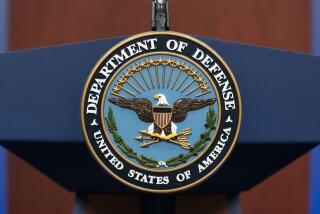Senate Backs Bush; Carrier Enters Gulf : Congress: Lawmakers express fear that events are leading toward all-out war with Iraq. The Independence sends a ‘signal.’
- Share via
WASHINGTON — The Senate overwhelmingly approved President Bush’s handling of the Persian Gulf crisis Tuesday, despite growing concern among lawmakers that events are pushing the United States toward all-out war with Iraq.
Underscoring those concerns, the U.S. aircraft carrier Independence sailed into the Persian Gulf in what one official called a “visible demonstration” of American firepower, and Navy and Marine forces conducted large-scale amphibious landing exercises in the region.
The Pentagon said U.S. forces deployed to the Middle East as part of Operation Desert Shield now number more than 170,000 soldiers, sailors, airmen and Marines--an increase of 20,000 over figures released a week ago.
The Navy has 45 warships stationed in the gulf, the northern Arabian Sea and the Red Sea, with another 10 in the eastern Mediterranean, officials said. They include the battleship Wisconsin and three aircraft carriers with more than 200 combat aircraft.
The arrival of the Independence in the gulf marked the first time in more than 15 years that a U.S. carrier has entered the narrow waterway. Although the Pentagon sought to play down the significance of the deployment, officials in Saudi Arabia left no doubt that it was meant to send a message to Iraq’s President Saddam Hussein.
“Does this send a signal?” one Navy official asked rhetorically. “Hell, yes, it does!”
In New York, meanwhile, Secretary of State James A. Baker III said that there is a growing consensus in the United Nations to consider the use of military force against Iraq if the current trade embargo does not force Hussein to withdraw his troops from Kuwait.
“There is more of a willingness to consider some sort of approach like that (use of force), if it becomes necessary at some appropriate time, than we had anticipated there might be at this stage,” Baker told a news conference.
Italian Foreign Minister Gianni De Michelis said he sees an “astonishing convergence” of views in the United Nations supporting the use of force if the economic sanctions fail. He said that if Hussein does not yield within a few weeks, it will be necessary for the U.N. to take additional action.
If the Security Council decides to use military power, he said, Italy will commit its forces to the operation.
The Senate resolution supporting Bush was passed by a vote of 96 to 3 after Democratic and Republican leaders assured lawmakers that their carefully crafted approval of the President’s policies did not constitute a “blank check” for future military moves in the Persian Gulf.
“This resolution is not an authorization for the use of force, now or in the future,” Senate Majority Leader George J. Mitchell (D-Me.) said. “It does (not) represent approval for all future actions.”
Despite those assurances, concern was clearly mounting on both sides of the Capitol that the Bush Administration appeared to be edging closer to a decision to abandon economic sanctions in favor of military action to reverse Iraq’s occupation of Kuwait.
The Administration “is clearly thinking seriously about war in the Persian Gulf,” Rep. Les Aspin (D-Wis.) told a group of business leaders and government officials. “Real pressure (is) building for a resort to force earlier rather than later.”
Aspin, chairman of the House Armed Services Committee, cited four converging pressures on the Administration to go to war: public eagerness for an early end to the crisis; military considerations involving the best time to launch an offensive; the morale of U.S. forces in the Saudi desert, and the systematic dismantling of Kuwait by Iraqi occupation forces.
“President Bush may have to make his decision to go to war before the embargo has fully played out. . . . If (he) waits for the embargo to succeed or fail before deciding to go to war, there may be no country left to free,” Aspin said.
As lawmakers debated the gulf crisis, a joint force of as many as 15,000 Marines and Navy amphibious units staged practice landings in the gulf in one of the largest such exercises in years.
The Pentagon refused to disclose the location of the exercises, but numerous sources suggested that the Marines were landing on the beaches of Oman, near the tip of the Arabian peninsula.
Pentagon spokesman Pete Williams said the exercises, involving elements of the 4th Marine Expeditionary Brigade and Amphibious Attack Group 2, will continue through Friday.
Staff writers Douglas Jehl in Saudi Arabia, John M. Broder in Washington and Norman Kempster and Don Shannon in New York contributed to this report.
More to Read
Get the L.A. Times Politics newsletter
Deeply reported insights into legislation, politics and policy from Sacramento, Washington and beyond. In your inbox twice per week.
You may occasionally receive promotional content from the Los Angeles Times.










